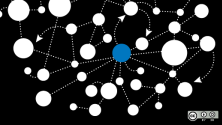Every interaction we have with another person is influenced by our emotions. Those emotions have ripple effects, especially when it comes to how you do business. A happy customer patronizes your business more, recommends it to family and friends, writes a positive review, and ultimately leads to more money being spent at your business than if they'd been disappointed. The most basic known variable of providing good customer service influences this: If something isn't going as expected, work to make it right (within reason), and you'll save the relationship.
In tech, you can respect this in a few ways. If you listen to customer feedback, create products they'll find useful and intuitive, and nurture those positive associations with your project, then you'll do well. But there's an oft overlooked component to your customer's emotional perception of your business, and that's the customer support team.
Customer support team
The interactions handled by a support team carry a high emotional charge for the customer. Software needs to work, and it needs to work now.
Software faces a unique challenge when it comes to how a customer-facing team builds a relationship: it's primarily a virtual interaction. For in-person customer care, an employee wields the superpower of eye contact, a strong emotional influence. Facial expressions force us to interact with more empathy than say, a voice over the phone, or an email response.
When that's not possible, though, the ability to shift the emotional tone to a calm one can be challenging. It's easy for a customer to have a natural bias toward online support. Maybe they've had a bad experience with heavily automated support in the past. There are plenty of badly configured chatbots, unnavigable phone menus, and dispassionate robotic voices to add fuel to the fire when emotions are already high. A customer may have talked to a support agent who's miserable at work and therefore apathetic to the outcome. The customer carries these experiences into their emotional approach when asking for help. This can create stress for the agent who picks up their ticket, and a vicious cycle repeats.
Because of high stakes, emotional nature of Customer Support (CS), your business has an opportunity. Corral these big emotions through the people who have the most access to them. The key to doing this successfully is to remember the ripple effect. A customer service agent with the necessary tools and knowledge at their fingertips is happy. A happy customer service agent has better conversations with customers. You can set yourself apart from competitors by creating happy customer support agents in an empowered and knowledgeable customer service team. How is this done?
Preparing for success
If you’re a leader in customer support, or a stakeholder elsewhere in the organization (engineering, product, and so on) who works with support a lot, you can work in key areas to make the lives of your support agents a little easier:
Create visibility
As a customer support agent, you need data about the customer you're helping. You need to know the systems your customer is using, and the products you're meant to support. It's crucial to have visibility into other teams in the organization, because they have that kind of data. You need to know who to ask for help when a problem arises, what the known issues are, what's being worked on already, and so on.
Siloed departments are a common major barrier to achieving visibility across teams. This can be made worse by tools and systems that don't connect departments, such as a spreadsheet directory or filing issues in an internal tracking tool. When this is the case, the customer service department can't get timely information on the status of an issue, and the engineering department can't get a good feel for how customers are experiencing the issue.
If your customer service team is given visibility into the complexity faced by your engineering teams, it's easier to clearly articulate the state of issues to customers and stakeholders. Customer service teams can create visibility for engineering, too. Crucial information about problems can come from your customers. When engineering has visibility into customer issues, they're better equipped to prioritize for customer needs.
Everyone works hard to prevent customers from being affected by issues, but that's not always realistic. Use the data your customers give your customer service team about what's wrong, and empower your customer service agents to become part of an incident response process rather than just reacting to it.
Make difficult moments easy
Customer support is a difficult job. If you have never worked in customer service, I'm giving you some homework: shadow your customer support team so you can understand where friction happens. It's a great way to get to know who your customers really are, by seeing them in their highest emotional moments, and seeing how your team navigates that. Customer service means all the questions coming your way, few of the answers at your fingertips, manual tasks to complete, and not enough people to share the load.
Make the job easy for customer service where you can. It will pay off. Maybe you can help the team automate mundane tasks to better focus on more interesting problems. Often this manifests in chatbots, but it's worth being creative here. For example, can automation be applied when escalating tickets to engineering? That could free an agent to work on their troubleshooting process, rather than the manual steps of making that escalation happen.
You can use tooling your engineering team might already have in place to find these opportunities. Operations platforms can be shared to put both team's metrics out in the open, helping everyone stay aligned on common goals.
The feedback loop required for a mature software development life cycle needs the customer service team to operate effectively. You can only do that with shared visibility across your organization.
Making it easy also means proactive design, especially when it comes to processes for critical moments. You probably have a process to manage major incidents. When you share these tools and processes with customer service, you enable greater visibility and gain valuable insight and teammates along the way. During an incident, customer service can play a few key roles:
Aggregating customer reported issues
When an incident triggers, engineering needs to quickly find out how much of the service is impacted, including how many features, the depth to which they are affected, and whether they are slow or completely offline. Customer impact is part of that, which customer service can help uncover by associating inbound customer complaints to technical incidents to help drive priorities. As customer service receives reports of issues during an incident, that data becomes part of the impact of the incident, and is incorporated into the resolution process.
Prioritization of SLA
Your customer service team is in a unique position to help confirm the impact of an incident on the end user. They have insight into when services are reaching their Service Level Agreement (SLA) for certain customers, and can alert the responding team. This is an important piece of information to manage, and engineering teams might not have visibility into those contractual agreements. This aids in the prioritization of issues during incidents. CS can advise on whether or not an incident should be escalated or have its severity increased based on the customer intelligence they are receiving. More customer impact could mean a higher severity level for the incident, more responders included in the triage, and more stakeholders informed.
Liaisons and stakeholder communication
Speaking of stakeholders, customer service can take the lead when it comes to codifying communication practices for incidents. Customer service can take ownership of policies around messaging for customers, template responses, and communication processes. Templates with clear information and status pages to keep up to date are just some of the assets they can manage.
Post-incident follow-up
You'll always encounter customers who watch your status page like a hawk for updates. These customers and others ask customer service for updates if they don't see progress. You can ease the cognitive load of responding to these customers with the newfound connection with the incident process. If you hold incident reviews, then customer service must be part of that conversation. The tone of a conversation changes when a customer service agent has extra data to present to users about the impact of the incident, the resolution, and long-term plans for prevention. Your customer feels consistency, and your agent feels real ownership of the conversation.
At the end of the day, involving your customer service team through the entire process, from start to finish, allows them to gain control of their own destiny. It lets them provide valuable input back into the resolution process, and leverage their improved experience to improve the customer experience.
Invest in people
You can't create a happy employee out of thin air. Customer service leaders need help doing this. People need investment in career growth, the ability to collaborate with their peers, and a voice in the organization to know that their feedback is heard.
Your customer support team is not here to report on metrics to the business or to slog through the queue. Investing means giving them time and space to expand their skills and grow in their careers. For customer service leaders, this comes with knowing you may not keep them in support forever. You can build a strong team that offers phenomenal support, and also creates a hiring funnel into the rest of the business.
The first level of this is up-leveling agents within support. It's common to have a "premium" support team, or similar, for customers who need a high touch level of support, and the ability to get help at any hour. Hiring 24x7 staff won't help a customer service leader redesign their team's status as a cost center, but developing a staffing model to use the existing team's time efficiently can. Sharing tooling with engineering can be one way to get there. For example, if engineering is on call for responding to issues, customer service can use the same tooling to provide a creative solution, rotating a specialized team for those odd hours or high priority issues.
This can open up a new career path for those who want to be on a team with specialized knowledge. Having a team that can be notified as-needed, rather than fully staffed at all times, staring at a queue, and waiting for incoming requests, allows leaders to scale their customer experience efficiently.
Empowering customer service teams to reach out to other teams and advocate for customers also creates new communications channels and opportunities. Your customer service team can serve as a gateway into your organization for technical personnel who are still building skills. A close relationship with engineering supports career growth. Shared processes promote this. So does a shadowing program, having a subject matter expert in support departments for different product areas, and intentionally building career paths to assist transitions when it's time to do so. Customer service agents who transition to other departments bring with them their customer focus and dedication to the customer experience. This is a valuable addition to teams in your organization which increases empathy across the board.
The modern software development life cycle doesn't end when code is checked into a repository and all the tests turn green. A constant feedback loop from users back into development planning links user requirements directly to the product management phase of the cycle. Organizations across various industries have seen the benefits of adopting shared goals and purposes across different teams. Include your customer service team in larger organization-wide initiatives, like DevOps transformations and automation projects. Doing this increases the effectiveness of customer-focused teams, and improving their day-to-day work in turn improves the experience they can provide for customers. In a nutshell: Happy agents translate to happy customers.







Comments are closed.